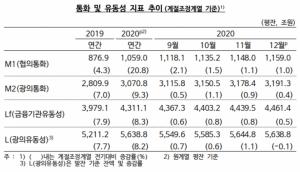Annual average of 3071 trillion won released from Corona 19 response

Last year, when interest rates fell and fiscal spending increased in the aftermath of Corona 19, the rate of money released was the fastest in 11 years. Last year, the amount of money on the market reached 3071 trillion won, an increase of 9.3% compared to the previous year. It is the highest since 2009 (10.3%), the period of the past financial crisis.
According to the’Money and Liquidity in December 2020′ announced by the Bank of Korea on the 17th, last year’s annual monetary volume (M2) was estimated at 3070 trillion won (average balance for seasonal adjustments). This is an increase of 26.900 trillion won (9.3%) from 28.09 trillion won in 2019.
M2 is a broad indicator of money stock. Cash and demand deposits covered by the negotiated currency (M1), money market funds (MMF) and term deposits (less than 2 years), transferable deposit certificates (CD), redemption conditional bonds (RP), short-term financial instruments for deposits with occasional deposits and withdrawals And the like.
Last year, M2 surpassed 3,000 trillion won for the first time since April in the aftermath of Corona 19. After that, the money continued to increase, reaching 3100 trillion won from August.
According to the BOK, the annual growth rate of 9.3% last year was the highest since the 10.3% increase in 2009 recorded during the past financial crisis. The growth rate of M2 in 2019 was 7%, and the years that exceeded the growth rate in 2019 in recent years were about 2015 (8.6%) and 2016 (7.3%).
By subject, the M2 of a company increased from 751 trillion 634.2 billion won in 2019 to 861 trillion863.6 billion won last year, an increase of 110 trillion 229.4 billion won (14.7%) from the previous year. During the same period, households (including non-profit organizations) M2 also increased from 1455 trillion 17.7 billion won to 1562 trillion769.5 billion won, which is 107.751.8 billion won (7.4%).
However, in December of last year, M2 increased by 13 trillion won from the previous month, recording 0.4%. This is a slower pace than the 1.1% and 0.9% increase from the previous month in October and November of last year.
In December, M2 of households (8.9 trillion won), businesses (5.4 trillion won) and other sectors (2 trillion won) increased, but other financial institutions (4.5 trillion won) declined.
Among financial products, the increase was centered on regular deposits (8.6 trillion won) and savings-type deposits (7 trillion won).
A BOK official said, “Basically, as the economy grows, the money supply expands,” he said. “Usually, at the end of the year, companies tend to reduce their debt in terms of balance sheet management, so it seems that the same effect was applied last year.”
Copyright © Shin-A Ilbo Unauthorized reproduction and redistribution prohibited
